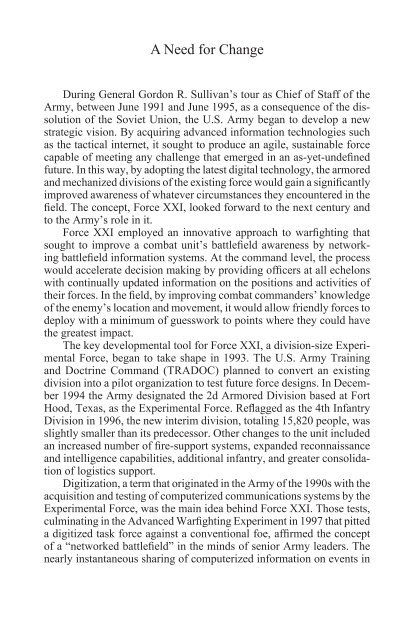From TransFormaTion To CombaT The First stryker brigade at War
From TransFormaTion To CombaT The First stryker brigade at War
From TransFormaTion To CombaT The First stryker brigade at War
You also want an ePaper? Increase the reach of your titles
YUMPU automatically turns print PDFs into web optimized ePapers that Google loves.
A Need for Change<br />
During General Gordon R. Sullivan’s tour as Chief of Staff of the<br />
Army, between June 1991 and June 1995, as a consequence of the dissolution<br />
of the Soviet Union, the U.S. Army began to develop a new<br />
str<strong>at</strong>egic vision. By acquiring advanced inform<strong>at</strong>ion technologies such<br />
as the tactical internet, it sought to produce an agile, sustainable force<br />
capable of meeting any challenge th<strong>at</strong> emerged in an as-yet-undefined<br />
future. In this way, by adopting the l<strong>at</strong>est digital technology, the armored<br />
and mechanized divisions of the existing force would gain a significantly<br />
improved awareness of wh<strong>at</strong>ever circumstances they encountered in the<br />
field. <strong>The</strong> concept, Force XXI, looked forward to the next century and<br />
to the Army’s role in it.<br />
Force XXI employed an innov<strong>at</strong>ive approach to warfighting th<strong>at</strong><br />
sought to improve a comb<strong>at</strong> unit’s b<strong>at</strong>tlefield awareness by networking<br />
b<strong>at</strong>tlefield inform<strong>at</strong>ion systems. At the command level, the process<br />
would acceler<strong>at</strong>e decision making by providing officers <strong>at</strong> all echelons<br />
with continually upd<strong>at</strong>ed inform<strong>at</strong>ion on the positions and activities of<br />
their forces. In the field, by improving comb<strong>at</strong> commanders’ knowledge<br />
of the enemy’s loc<strong>at</strong>ion and movement, it would allow friendly forces to<br />
deploy with a minimum of guesswork to points where they could have<br />
the gre<strong>at</strong>est impact.<br />
<strong>The</strong> key developmental tool for Force XXI, a division-size Experimental<br />
Force, began to take shape in 1993. <strong>The</strong> U.S. Army Training<br />
and Doctrine Command (TRADOC) planned to convert an existing<br />
division into a pilot organiz<strong>at</strong>ion to test future force designs. In December<br />
1994 the Army design<strong>at</strong>ed the 2d Armored Division based <strong>at</strong> Fort<br />
Hood, Texas, as the Experimental Force. Reflagged as the 4th Infantry<br />
Division in 1996, the new interim division, totaling 15,820 people, was<br />
slightly smaller than its predecessor. Other changes to the unit included<br />
an increased number of fire-support systems, expanded reconnaissance<br />
and intelligence capabilities, additional infantry, and gre<strong>at</strong>er consolid<strong>at</strong>ion<br />
of logistics support.<br />
Digitiz<strong>at</strong>ion, a term th<strong>at</strong> origin<strong>at</strong>ed in the Army of the 1990s with the<br />
acquisition and testing of computerized communic<strong>at</strong>ions systems by the<br />
Experimental Force, was the main idea behind Force XXI. Those tests,<br />
culmin<strong>at</strong>ing in the Advanced <strong>War</strong>fighting Experiment in 1997 th<strong>at</strong> pitted<br />
a digitized task force against a conventional foe, affirmed the concept<br />
of a “networked b<strong>at</strong>tlefield” in the minds of senior Army leaders. <strong>The</strong><br />
nearly instantaneous sharing of computerized inform<strong>at</strong>ion on events in

















